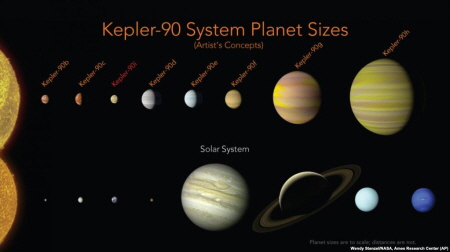
   |
[Headlines] (HL-과학/기술/교육) Newly Discovered Solar System Matches Our Own
최고관리자 | 18-01-02 23:19

The American space agency NASA and the technology company Google have identified an eighth planet in a faraway solar system. That solar system now has exactly the same number of planets as our own. Machines made the surprising discovery, not human researchers. NASA and Google representatives made a joint announcement about the discovery on December 14. The newly discovered planet orbits the star known as Kepler-90. The system is about 2,545 light-years away. A light-year is about 9.5 trillion kilometers. Researchers have named the planet Kepler-90i. Like Earth, Kepler-90i is the third farthest planet from its sun. However, Kepler-90i is much closer to its sun. It only takes the planet 14 days to orbit Kepler-90. So, its surface is much warmer -- 427 degrees Celsius. In fact, all the planets in the Kepler-90 solar system orbit closer to their sun than Earth does to our sun. So far, this is the only other eight-planet solar system that researchers have found. Eight is the largest number of planets ever observed around a single sun.
* space agency = 항공 우주국/ identify = 찾다, 발견하다; (신원 등을) 확인하다[알아보다]/ faraway = 멀리 떨어진/ solar system = 태양계/ orbit = (다른 천체의) 궤도를 돌다/ light-year = 광년(빛이 1년간 나아가는 거리. 9.4607 x 1012 킬로미터)
Our solar system had nine planets up until 2006, when the International Astronomical Union decided Pluto did not meet the requirements to be considered a planet. Instead, the group renamed it a dwarf planet. But some astronomers believe there could be a large ninth planet far off in our solar system. They call it Planet X, and believe it is the size of Neptune. Researchers also believe there could be nine or more planets in the Kepler-90 solar system. Google used data from NASA’s special planet-hunting device, called the Kepler Space Telescope, to locate Kepler-90i. The company used the data to develop a computer program with machine learning. This means it can learn and improve itself without a programmer telling it to do so. The program carefully studies planetary signals that are so weak it would take humans years to examine them. Christopher Shallue is a senior software engineer at Google in Mountain View, California. He said, “This is a really exciting discovery, and we consider it to be a successful proof of concept to be using neural networks to identify planets, even in situations where the signals are very weak.”
* Pluto = 명왕성/ meet the requirements = 조건을 충족시키다/ planet = 행성/ dwarf planet = 왜소행성(矮小行星)/ astronomer = 천문학자/ far off = 아득히 저편/ Neptune = 해왕성/ space telescope = 우주 망원경/ machine learning = 기계 학습 (자신의 동작을 스스로 개선할 수 있는 슈퍼 컴퓨터의 능력)/ neural network = 신경망
   |




